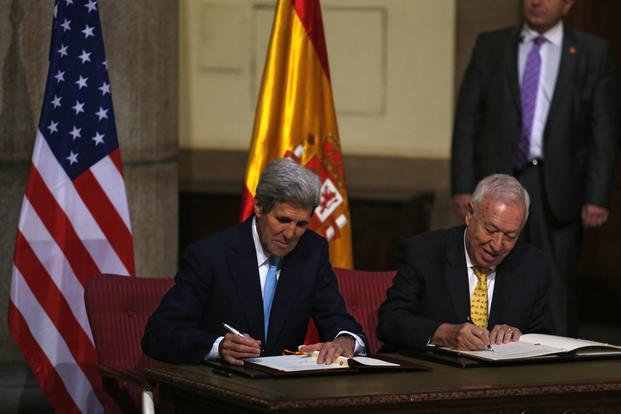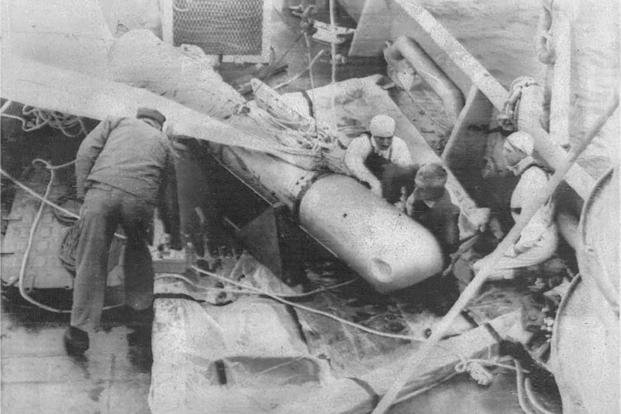If not for a Spanish fisherman who saw something and said something, the U.S. Air Force might never have recovered a missing hydrogen bomb during the Cold War.
On Jan. 17, 1966, Francisco Simo y Orts was going about his day in the coastal town of Palomares when a U.S. Air Force B-52 bomber and KC-135 Stratotanker collided during a refueling mission. The subsequent explosions caused Orts to look skyward, where he saw what he believed to be a crew member strapped to a parachute. Orts reported the sighting, but although he had no way of knowing it at the time, he was mistaken.
What Orts witnessed almost certainly was not an airman escaping a fiery death, but rather a nuclear bomb attached to a parachute. It landed in the Mediterranean Sea, and Orts’ observation ultimately helped the U.S. military recover the explosive after an exhaustive search.
The B-52 had left Seymour Johnson Air Force Base in North Carolina on Jan. 16 as part of Operation Chrome Dome. Under that ambitious program, the Air Force was required to fly 12 B-52s constantly on routes within striking distance of the Soviet Union, with each bomber in the air for roughly 24 hours before being replaced. Those aircraft carried thermonuclear weapons, including the codes to arm them, to deter Soviet aggression and allow the U.S. to respond more quickly in case of attack.
Read Next: How Airmen Started a Golf Club in the Nazi POW Camp Known for ‘The Great Escape’
On this flight, an aircraft tanker was refueling the B-52 — which was carrying four Mark 28 bombs — for the third time when the bomber approached it too quickly. About 31,000 feet above the ground, the KC-135’s fueling boom rammed the B-52, severing its left wing and causing both aircraft to explode.
All four K-135 crew members were killed, as were three of the seven aboard the B-52. Along with pieces of the fuselage, several bombs fell from the sky, too. Three of the weapons were discovered relatively quickly, but the whereabouts of the fourth bomb was unknown.
Believing it might have landed in the Mediterranean, the Air Force called upon the Navy’s deep submersibles program. After conferring with a collection of mathematicians, submariners and salvage experts, program chief John Craven made his best guess for where the missing bomb was located, but it was only a calculation.
They needed something firmer, such as an eyewitness account, and fortunately they had one. Now realizing that Orts, the fisherman, might have seen the stray bomb drifting over the water, they used his recollection to narrow their focus to a one-mile area.
Along with 33 ships — part of a task force commanded by Rear Adm. William Guest — the Navy deployed manned and unmanned submersibles to join the frantic search. Two months after the collision, one of the underwater vessels, the USS Alvin, located the bomb on a steep slope nearly 2,600 feet below the surface. Over the next 1½ weeks, attempts were made to secure the 70-kiloton explosive, but before it could be properly secured, bad weather created underwater currents that threatened to shift its position.
Not wanting to risk losing track of the bomb, Guest authorized the lifting of the Mark 28 explosive despite only one line being connected to it. After an hour, the USS Hoist — a rescue and salvage ship — had pulled the bomb within just 50 feet of the surface when a dangerous swell caused the line to snap.
As the bomb again descended into the Mediterranean, the Navy’s hopes of retrieving it seemingly sank as well. Nine days of uncertainty painstakingly passed until the bomb was relocated on April 2 in about 2,800 feet of water. A cable-controlled underwater recovery vehicle, or CURV, was assigned to retrieve the bomb this time. With the nuclear weapon precariously positioned near a deep canyon, it took five more anxiety-filled days until the USS Petrel, a recovery ship, pulled the explosive onto its deck on April 7.

Although the Mark 28’s tail was cut up and its nose dented, it had not detonated and was intact. Disaster was seemingly averted. But the incident at Palomares did not end there, because two of the bombs that landed in the village had shattered and deposited plutonium, a radioactive carcinogen, into the ground.
Approximately 1,600 Air Force personnel were involved in the massive cleanup, collecting some 1,400 tons of dirt that were shipped to South Carolina for disposal. Those service members were given little protective gear, and although the Air Force long claimed there was no harmful radiation at Palomares, that was inaccurate. In 2016, The New York Times reported that 21 of 40 veterans whom it identified as assisting with the cleanup later developed cancer.
“First they denied I was even there, then they denied there was any radiation,” veteran Ronald Howell told the Times then after recently having a brain tumor removed. “I submit a claim, and they deny. I submit [an] appeal, and they deny. Now I’m all out of appeals.
“Pretty soon, we’ll all be dead, and they will have succeeded at covering this whole thing up.”

In the past decade, however, the United States has begun acknowledging the damage those compromised bombs caused at Palomares. Under a 2015 agreement, the United States and Spain agreed that about 1.1 pounds of plutonium — a staggering amount, considering that less than a microgram can lead to cancer — remained in the area and committed to address the toxin’s removal.
Then with the signing of the PACT Act in 2022, the Department of Veterans Affairs now considers any veterans who served in various “radiation risk activities,” including at the Palomares cleanup, to have a presumptive condition. For more information, call the Veterans Benefits Administration National Call Center at 1-800-827-1000.
Want to Know More About the Military?
Be sure to get the latest news about the U.S. military, as well as critical info about how to join and all the benefits of service. Subscribe to Military.com and receive customized updates delivered straight to your inbox.
Story Continues
Read the full article here

